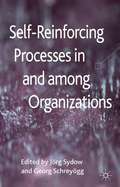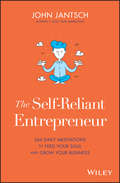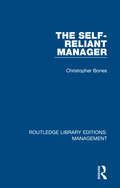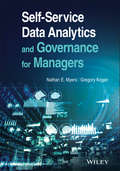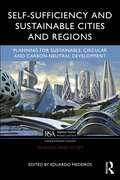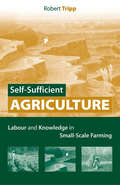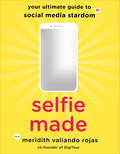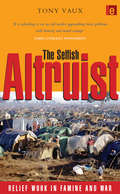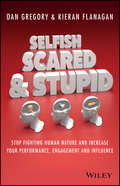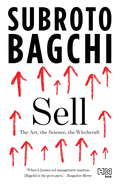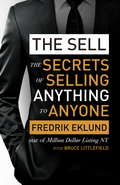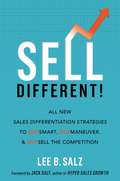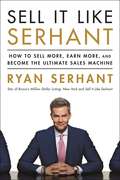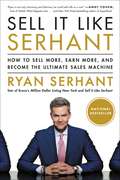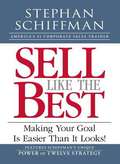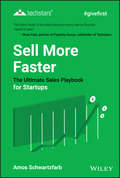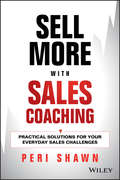- Table View
- List View
Self-Regulation and Legalization
by Annegret FlohrDeparting from an International Relations perspective, this book inquires how industry self-regulation affects the role of international law in governing global banks. It provides case studies of the Wolfsberg Principles and the Equator Principles.
Self-Reinforcing Processes in and among Organizations
by Jörg Sydow Georg SchreyöggManagement and organization research has rediscovered individual agency, innovation and entrepreneurship. As such, there is a risk of overlooking the power of self-reinforcing processes in and among organizations. This volume redirects attention to these processes, including: escalating commitment, organizational imprinting and path dependence.
The Self-Reliant Entrepreneur: 366 Daily Meditations to Feed Your Soul and Grow Your Business
by John JantschA guide for creating a deeper relationship with the entrepreneurial journey The Self-Reliant Entrepreneur offers overworked and harried entrepreneurs, and anyone who thinks like one, a much-needed guide for tapping into the wisdom that is most relevant to the entrepreneurial life. The book is filled with inspirational meditations that contain the thoughts and writings of notable American authors. Designed as a daily devotional, it is arranged in a calendar format, and features readings of transcendentalist literature and others. Each of The Self-Reliant Entrepreneur meditations is followed by a reflection and a challenging question from John Jantsch. He draws on his lifetime of experience as a successful coach for small business and startup leaders to offer an entrepreneurial context. Jantsch shows how entrepreneurs can learn to trust their ideas and overcome the doubt and fear of everyday challenges. The book contains: A unique guide to meditations, especially designed for entrepreneurs A range of topics such as self-awareness, trust, creativity, resilience, failure, growth, freedom, love, integrity, and passion An inspirational meditation for each day of the year. . . including leap year Reflections from John Jantsch, small business marketing expert and the author of the popular book Duct Tape Marketing Written for entrepreneurs, as well anyone seeking to find a deeper meaning in their work and life, The Self-Reliant Entrepreneur is a practical handbook for anyone seeking to embrace the practice of self-trust.
The Self-Reliant Manager (Routledge Library Editions: Management #15)
by Christopher BonesOriginally published in 1994. What is a self-reliant manager? The self-reliant manager is one who can grow an organization by exploiting his or her role in the management of people. Not every manager is involved in top-level decision-making and the development of global strategies. Every manager is, however, by being involved in managing the people in an organization, empowered to take the company forward. The book covers key topics such as empowerment, motivation, performance appraisal, the development of management learning systems, environmental awareness, ethics, and management style. It presents a model to show how managers can improve their own effectiveness. To succeed with people, managers need to understand themselves, the internal framework of their organization and the external environment in which their business operates. They have become self-reliant to develop the leadership and vision needed to influence their organization.
Self-Service Data Analytics and Governance for Managers
by Nathan E. Myers Gregory KoganProject governance, investment governance, and risk governance precepts are woven together in Self-Service Data Analytics and Governance for Managers, equipping managers to structure the inevitable chaos that can result as end-users take matters into their own hands Motivated by the promise of control and efficiency benefits, the widespread adoption of data analytics tools has created a new fast-moving environment of digital transformation in the finance, accounting, and operations world, where entire functions spend their days processing in spreadsheets. With the decentralization of application development as users perform their own analysis on data sets and automate spreadsheet processing without the involvement of IT, governance must be revisited to maintain process control in the new environment. In this book, emergent technologies that have given rise to data analytics and which form the evolving backdrop for digital transformation are introduced and explained, and prominent data analytics tools and capabilities will be demonstrated based on real world scenarios. The authors will provide a much-needed process discovery methodology describing how to survey the processing landscape to identify opportunities to deploy these capabilities. Perhaps most importantly, the authors will digest the mature existing data governance, IT governance, and model governance frameworks, but demonstrate that they do not comprehensively cover the full suite of data analytics builds, leaving a considerable governance gap. This book is meant to fill the gap and provide the reader with a fit-for-purpose and actionable governance framework to protect the value created by analytics deployment at scale. Project governance, investment governance, and risk governance precepts will be woven together to equip managers to structure the inevitable chaos that can result as end-users take matters into their own hands.
Self-Sufficiency and Sustainable Cities and Regions: Planning for Sustainable, Circular and Carbon-Neutral Development (Regions and Cities)
by Eduardo MedeirosThe concept of self-sufficiency involves the notion of sustainable, circular, and carbon-neutral cities. This book examines how urban planning can lead to greater self-sufficiency.It sheds light on how urban and regional circular and self-sufficiency development can effectively contribute towards the ultimate goals of the United Nations (UN) Agenda 2030 and the European Union (EU) Green Deal. It not only embraces the scientific fields of regional and urban studies but also addresses environmental sustainability-related and regional resilience aspects, such as renewable energy production, sustainable mobility, and the circular economy. This book offers a full toolkit of knowledge on how to effectively implement planning approaches for circular and self-sufficiency development at both urban and regional levels. It begins by presenting a theoretical framework and debate on urban and regional planning approaches that can effectively make cities and regions circular and self-sufficient in certain development domains, such as producing intra-city electric energy, sustainable mobility, and promoting a circular economy. Further, it advances a range of policy development proposals aiming at providing a comprehensive introduction to contemporary thinking about how cities and regions can design innovative planning and governance processes and, where appropriate, build capacity to implement systemic and integrated climate-neutral policies, building on existing place-based territorial capital and experiences developed by local and regional networks. The chapters are written by established authors in their respective domains.This book will thoroughly prepare students and provide knowledge to academics, researchers, and policymakers in the fields of urban and regional planning/development and studies, environmental sustainability, regional resilience, human geography, economic development, and public/EU/UN policies.
Self-Sufficient Agriculture: Labour and Knowledge in Small-Scale Farming
by Robert TrippLow external-input technology (or LEIT) is an increasingly prominent subject in discussions of sustainable agriculture. There are growing calls for self-sufficient agriculture in an era experiencing diminishing returns from reliance upon expensive synthetic pesticides and fertilizers. There are many reasons to support strategies for low external input farming, including a concern for environmental sustainability, increased attention to resource-poor farmers and marginal environments, and the conviction that a better use of local resources in small-scale agriculture can improve farm productivity and innovation. But despite the increased attention to self-sufficient agriculture, there is little evidence available on the performance and impact of LEIT. This book examines the contributions and limitations of low external input technology for addressing the needs of resource-poor farmers. For the first time a balanced analysis of LEIT is provided, offering in-depth case studies, an analysis of the debates, an extensive review of the literature and practical suggestions about the management and integration of low external input agriculture in rural development programmes.
Selfie Made: Your Ultimate Guide to Social Media Stardom
by Meridith Valiando RojasHOW DO I MAKE IT BIG ON SOCIAL MEDIA? WHAT IS MY STORY—AND WHO IS MY AUDIENCE? WHAT CONTENT SHOULD I POST TO ACHIEVE #SUCCESS? HOW DO I GO VIRAL…OR HOW LONG WILL IT TAKE ME TO GET NOTICED?Selfie Made is a one-of-a-kind guide to creating a digital identity, finding an audience, and building a powerful brand—your own!—on the Internet. Whether you want to be in front of or behind the camera, produce click-worthy content or start your own business, this book is the place to begin. Written by Meridith Valiando Rojas, the hugely successful (and super friendly IRL) founder of DigiTour who has worked with every major star from YouTube to Musical.ly, this collection of personal anecdotes and professional advice, tricks of the trade and behind-the-screen secrets, will give you everything you need for your social media toolkit.Here, you’ll get to know the true stories behind some of today’s most successful multimedia stars and influencers, including:Max And Harvey - Blake Gray - Danielle CohnBryce Xavier - Lauren Godwin - Nathan TriskaTrevor Moran - Messy Monday - Simon Britton…and others who learned the ropes, beat the odds, and took social media by storm. And so can you!
The Selfish Altruist: Relief Work in Famine and War
by Tony VauxProvides an analysis of some of the most traumatic situations involving famine and war of the last two decades, helping us to understand what it takes to be an aid worker and how important humanitarian action is today. Famine and war evoke strong emotional reactions, and for most people there is a limited amount they can do. But the relief worker has to convert emotional responses into practical action and difficult choices - whom to help and how. Their own feelings have to motivate action for others. But can they separate out their own selfish feelings and prejudices in such an emotive climate? How do they avoid being partial among those they are helping? Are they motivated by altruistic concern, or the power they experience or the attention they receive? Tony Vaux brings over 20 years experience as one of Oxfam's leading emergency managers to the exploration of the conflicts between subjective impulses and objective judgements and the dilemmas relief workers contend with.
Selfish, Scared and Stupid
by Kieran Flanagan Dan GregoryAppealing to humans' basic instincts to increase influence,buy-in and results Survival of the species comes down to three basic instincts, saybehavioural research strategists Dan Gregory and KieranFlanagan--fear, self-interest and simplicity. These basichuman behaviours come into play in all types of relationships,including those between businesses and customers. Selfish,Scared and Stupid: Stop fighting human nature and increase yourperformance, engagement and influence, demystifies thesebehaviours and examines the psychology behind why even the bestideas sometimes fail.This book helps businesses design their organisations forreality rather than perfection, and also offers strategies to headoff unprecedented levels of disengagement within, and outside, thebusiness. It answers baffling questions around why the publicsometimes fails to engage despite overwhelming data suggestingotherwise, why so many new products end up on clearance shelves andwhy so many great salespeople often fall short of their monthlytargets.Learn how the survival of the species plays into business,including delusionary realities and the reasons ideas can failDiscover how to offer customers strategic rewards, therebymaking the buying process more attractive to selfish naturesExamine the link between fear and the unknown, includingstrategies for quelling fears and turning them into actionLearn to use a simple mindset to create low-involvementproducts, helping appeal to instinct and making products hard toresistThis provocative book is built on the idea that businesses mustreturn to a more human engagement methodology in order to succeed.It is an informative read for anyone interested in improvinginfluence, growing business reach, improving sales figures orunderstanding the complexities of human behaviour.
The Selfless Gene: Living With God And Darwin
by Charles FosterIn THE SELFLESS GENE, Charles Foster assesses the claims of Neo-Darwinists and Young Earth Creationists, demonstrating that orthodox Christianity is not incompatible with what evolutionary biology says about our world. The real issue, he argues, centres around the ethical implications of natural selection, and what such a system ? based on selfishness, waste and death ? might say about the loving creator God of the Christian faith.Intelligent, provocative and accessible, THE SELFLESS GENE offers the prospect of a reasoned dialogue between faith and scientific study, and a reconciliation of what are popularly seen as two opposing worldviews.In THE SELFLESS GENE, Charles Foster assesses the claims of Neo-Darwinists and Young Earth Creationists, demonstrating that orthodox Christianity is not incompatible with what evolutionary biology says about our world. The real issue, he argues, centres around the ethical implications of natural selection, and what such a system ? based on selfishness, waste and death ? might say about the loving creator God of the Christian faith. Intelligent, provocative and accessible, THE SELFLESS GENE offers the prospect of a reasoned dialogue between faith and scientific study, and a reconciliation of what are popularly seen as two opposing worldviews.
Seligram, Inc.: Electronic Testing Operations
by Christopher D. Ittner Peter B.B. Turney Robin CooperExplores the obsolescence of a cost system when technology changes. In particular, it asks students to increase the number of cost center and allocation bases. The firm moves from a one-center, direct labor-hour system to a three-center, direct labor-hour and machine-hour systems.
Sell: The Art, the Science, the Witchcraft
by Subroto BagchiAn inspiration to a generation of entrepreneurs, Subroto Bagchi considers himself a career salesman, of products, services and ideas. In his new book, Sell, Bagchi presents the concepts of selling and salesmanship from his unique perspective. Through stories and anecdotes drawn from his repertoire of experiences, extensive reading and the careers of ace professionals he has encountered in his life, Bagchi touches on each stage of the traditional selling process and elaborates on the skills, tools and nuances that he believes can take the profession to the realm of art ? and sometimes even wizardry. Dip into this book to get insights into: ? How knowing about the life-cycle of the coho salmon will help you prospect better; ? Distinguishing real customers with purchasing power from time-wasters who will merely give you the runaround; ? How creating a playbook well in advance can guarantee you a sale; ? The transformational effect of believing in the value of your product and how you can bring your customer around to share your vision; ? Why the power of persuasion ranks higher than the power to convince, and why persistence tends to become meaningless after a point. Marked by Bagchi?s characteristic wisdom and practicality, Sell is a rich, illuminating and contemporary treatise on salesmanship that dispels a narrow view of the act of selling and redefines it as a skill every professional needs to succeed in their career.
The Sell: The Secrets of Selling Anything to Anyone
by Barbara Corcoran Bruce Littlefield Fredrik EklundThe nation's #1 real estate broker and star of Bravo's Million Dollar Listing New York shares his secrets for superstar success and getting what you want out of life--no matter who you are or what you do.Ten years ago, Fredrik Eklund moved to New York City from his native Sweden with nothing but a pair of worn-out sneakers and a dream: to make it big in the city that never sleeps. Since then, he's become the top seller in the most competitive real estate market on the planet, brokering multimillion-dollar deals for celebrities, selling out properties all over the city, and charming audiences around the world as one of the stars of the hit Bravo series Million Dollar Listing New York.Now, for the first time, Fredrik shares his secrets so that anyone can find success doing what they love. According to Fredrik, even if you don't consider yourself a salesperson, you've been in sales your whole life because every day you are selling your most important asset: yourself. Whenever you influence, persuade or convince someone to give you something in exchange for what you've got--whether it's a luxury home, a great idea at work, or your profile on Match.com--you are selling. And if you know how to sell the right way, you can live your dream. That is what The Sell is all about. Blending personal stories, hilarious anecdotes, and the expertise he's gained from his meteoric rise, Fredrik has written the modern guide on becoming successful, a book that tells you how to recognize and cultivate your true talents and make the ultimate sell. From the importance of being your most authentic self to looking like a million bucks even if you don't have a million bucks (yet!), he shows how intangible factors like personality and charm can get you noticed and make you shine. He also shares his tips and tricks for preparing, persuading, and negotiating so that in any of life's dealings, you'll come out a winner. Whether you work on Wall Street or at Wal-Mart, aim to become the top seller at your company or want to impress a first date, The Sell will help you have more personal and professional success, lead a rich and fulfilling life, and have fun along the way. From the Hardcover edition.
The Sell: The secrets of selling anything to anyone
by Fredrik Eklund Bruce Littlefield'With The Sell, Fredrik Eklund has created the modern day How to Win Friends and Influence People. If you're looking for how to achieve success in the 21st century, the answer is in your hands' Tom Doctoroff, CEO, J. Walter Thompson, and author of Twitter is Not a StrategyJust over a decade ago, Fredrik Eklund moved to New York City from his native Sweden with nothing but a worn-out pair of sneakers and a dream: to make it big in the city that never sleeps. Despite having no experience in real estate and no contacts, Fredrik transformed himself into the best seller in the most competitive real estate market on the planet, brokering multimillion-dollar deals for celebrities, selling out properties all over the city and charming TV audiences as one of the stars of Million Dollar Listing New York.Blending personal stories and the expertise he's gained from his meteoric rise, The Sell is the modern guide to becoming successful. Featuring everything from the importance of intangible factors like personality and charm, to tips and tricks for preparing, persuading and negotiating, The Sell is a vital go-to book for anyone who wants to have an impact in his or her personal and professional life. No matter what your background is - sales rep, CEO or kitchen-table entrepreneur - this book will help you sell yourself or your brand, and lead a richer, more fulfilling life.
The Sell: The secrets of selling anything to anyone
by Fredrik Eklund Bruce LittlefieldTen years ago, Fredrik Eklund moved to New York City from his native Sweden with nothing but a worn-out pair of sneakers and a dream: to make it big in the city that never sleeps. Despite having no experience in real estate and no contacts, Fredrik transformed himself into the best seller in the most competitive real estate market on the planet, brokering multimillion-dollar deals for celebrities, selling out properties all over the city and charming TV audiences as one of the stars of Million Dollar Listing New York.In The Sell, Fredrik shares his secrets so that anyone can find success doing what they love. According to Fredrik, even if you don't consider yourself a salesperson, you've been in sales your whole life because every day you are selling your most important asset: yourself. Whenever you influence or persuade someone to give you something in exchange for what you've got - whether it's a luxury home, a great idea at work, or your profile on Match.com - you are selling. And if you know how to sell right, you can live your dream.Blending personal stories and the expertise he's gained from his meteoric rise, The Sell is the modern guide to becoming successful. Featuring everything from the importance of intangible factors like personality and charm, to tips and tricks for preparing, persuading and negotiating, The Sell is a vital go-to book for anyone who wants to have an impact in his or her personal and professional life. No matter what your background is - sales rep, CEO or kitchen-table entrepreneur - this book will help you sell yourself or your brand, and lead a richer, more fulfilling life.
Sell (New, Engaging Titles From 4ltr Press Series)
by Thomas N. Ingram Raymond Buddy W. LaForge Ramon A. Avila Charles H. Schwepker Michael R. WilliamsLearn Principles of Selling YOUR Way with SELL5! SELL5's easy-reference, paperback textbook presents course content through visually-engaging chapters as well as Chapter Review Cards that consolidate the best review material into a ready-made study tool. <P><P>With the textbook or on its own, SELL Online allows easy exploration of SELL5 anywhere, anytime - including on your device! Collect your notes and create StudyBits(TM) from interactive content as you go to remember what's important. <P><P>Then, either use preset study resources, or personalize the product through easy-to-use tags and filters to prioritize your study time. Make and review flashcards, review related content, and track your progress with Concept Tracker, all in one place and at an affordable price!
Sell Different!: All New Sales Differentiation Strategies to Outsmart, Outmaneuver, and Outsell the Competition
by Lee B. SalzGame-changing new strategies to outsmart, outmaneuver, and outsell your competition!Salespeople face fierce competition in their pursuit of winning deals. Differences in product features and functions get smaller by the minute and are not always meaningful to buyers.How do you stand out from the pack and not just land the account, but win deals at the prices you want?Lee B. Salz&’s previous ground-breaking, bestselling book, Sales Differentiation, armed salespeople with strategies to differentiate both what they sell and how they sell it. Sell Different! provides a new component of Sales Differentiation strategy to help you outsmart, outmaneuver, and outsell the competition to win more deals at the prices you want. This book provides you with the tools you need to land new accounts and grow existing ones.The practical, proven strategies presented in Sell Different! include:How to defeat your toughest competitor (hint: it&’s not who you think it is)An actionable 16-phase plan to reach and engage elusive prospectsFinding more of your best clients (it&’s easier than you think)Acquiring more referrals than you ever dreamed possibleVirtual selling and how to harness its potentialNeutralizing the fear of change that paralyzes buyers and kills dealsStructuring pilot programs that advance your dealsIdentifying the critical person needed to win more deals at the prices you wantSolving closing problems and fixing the real issue limiting your successDissecting and resolving the most challenging sales objection — price!What 99.999% of salespeople don&’t do, but shouldExpanding account relationships to explode revenue and lock out the competitionHow to address a major flaw when comparing salespeople with professional athletesAnd much, much more!If you are a salesperson, executive, or business owner who desires to win more deals at the prices you want, then this book is for you.
Sell It Like Serhant: How to Sell More, Earn More, and Become the Ultimate Sales Machine
by Ryan SerhantA lively and practical guide to selling anything'Ryan is not only charming and hilarious, he could sell milk to a cow. This book is going to be very helpful and humorous to a lot of people looking to up their business game' Andy Cohen, host of Watch What Happens Live... and New York Times bestselling author of SuperficialRyan Serhant was a shy, jobless hand model when he entered the real estate business in September 2008. Just nine years later, he has emerged as one of the top salespeople in the world and a co-star on Bravo's hit series Million Dollar Listing New York, as well as the star of Sell It Like Serhant. He has become an authority on the art of selling. Whether you are selling a property or a hot tub, golf balls or life insurance, Serhant shares the secrets behind how to close more deals than anyone else, expand your business, and keep clients coming back to you for more.Sell It Like Serhant is the blueprint for how to go from sales scrub to sales machine. Serhant provides useful lessons, lively stories, and examples that illustrate how anyone can employ his principles to increase profits and achieve success. Your measure of a good day will no longer depend on one deal or one client. A good salesperson never closes a deal and wonders, "What now?" The next deal is already happening. Serhant shares practical guidance on how to juggle multiple deals at once and close all of them EVERY. SINGLE. TIME. Sell It Like Serhant is a smart, at times hilarious, and always essential playbook to build confidence, generate results, and sell just about anything. You'll find tips on: * The Seven Stages of Selling* Getting FKD: How to Be a Time Manager, Not a Time Stealer* Negotiating Like A BOSS* "The One Who...": Everyone Needs a Hook* Pulling the Indecisive Client Forward* And Much More!Whatever your business or expertise, Sell It Like Serhant will make anyone a master at sales.Ready, set, GO!'Full of smart tricks and tips to make a seller out of you' PEOPLE.com'Whether you're in real estate or an author, you have to know how to sell yourself and your work. Because if you don't, you can't eat. This book from one of America's hardest hustling salesmen is a crash course into becoming great at it' Ryan Holiday, bestselling author of The Obstacle Is the Way and Ego Is the Enemy
Sell It Like Serhant: How to Sell More, Earn More, and Become the Ultimate Sales Machine
by Ryan SerhantThis national bestseller is a lively and practical guide on how to sell anything and achieve long-term success in business. Ryan Serhant was a shy, jobless hand model when he entered the real estate business in 2008 at a time the country was on the verge of economic collapse. Just nine years later, he has emerged as one of the top realtors in the world and an authority on the art of selling. Sell It Like Serhant is a smart, at times hilarious, and always essential playbook to build confidence, generate results, and sell just about anything. You'll find tips like: The Seven Stages of Selling How to Find Your Hook; Negotiating Like A BOSS; How to Be a Time Manager, Not a Time Stealer; and much more!Through useful lessons, lively stories, and vivid examples, this book shows you how to employ Serhant's principles to increase profits and achieve success. Your measure of a good day will no longer depend on one deal or one client, wondering what comes next; the next deal is already happening. And Serhant's practical guidance will show you how to juggle multiple deals at once and close all of them EVERY. SINGLE. TIME. Whatever your business or expertise, Sell It Like Serhant will make anyone a master at sales. Ready, set, GO!Sell It Like Serhant is a USA Today Bestseller, Los Angeles Times Bestseller, and Wall Street Journal Bestseller.
Sell Like A Spy: The Art of Persuasion from the World of Espionage
by Jeremy HurewitzSecond installment of the international bestseller, The Club.With a foreword by Robert Grenier, former Director of the CIA's Counterterrorism Center, learn the art of influence from the best salespeople in the world—spies. Tapping into the history of intelligence-gathering and his work with former agents of the CIA, FBI, and other federal departments, Jeremy Hurewitz, a foremost corporate sales and security expert, offers field-tested spycraft strategies and government-agency tactics anyone can use to build relationships, persuade, and sell anything.Hurewitz has built his career around CIA case officers, FBI agents, and government officials—people like Steve Romano, former Chief Negotiator of the FBI; Mark Sullivan, former Director of the Secret Service; General Stanley McChrystal (Ret.), former Commander of the Joint Special Operations Command; and John Cipher, former member of the CIA's Senior Intelligence Service. Drawing on in-depth interviews about their skillsets, stunning spy-world anecdotes, and science-backed principles of behavioral intelligence, Hurewitz has created a handbook of lessons and techniques that will strengthen your ability to connect, entice, and make deals—in business and everyday life.Though a spy's targets may be odious—terrorists, criminals, corrupt diplomats, and more—the agent's focus is on cultivating relationships and understanding motivations to gather information, free hostages, or procure money. Elicitation, Radical Empathy, and RPM (Rationalize, Project Blame, and Minimize Fault) are just a few methods in this persuasion playbook from the real world of international espionage.With a foreword by Robert Grenier, former Director of the CIA's Counterterrorism Center, Sell Like a Spy puts James Bond in its dust, making you a true agent of persuasion.
Sell Like the Best
by Stephan SchiffmanSome people are born to sell. Stephan Schiffman is not one of those people. But he is one of the best salespeople around-- because he patiently and carefully trained himself to watch born salespeople and learn how they did it. Now this acclaimed sales guru passes these secrets of successful selling on to you: Attitude is money Right attitude, right look Warming up to cold calling Getting the appointment Closing the deal If you follow Stephan Schiffman's winning formula, you can discover the right words and the right approach because you've not only learned to sell--you've learned to sell like the best.
Sell Like the Best
by Stephan SchiffmanSome people are born to sell. Stephan Schiffman is not one of those people. But he is one of the best salespeople around? because he patiently and carefully trained himself to watch born salespeople and learn how they did it. Now this acclaimed sales guru passes these secrets of successful selling on to you: Attitude is money Right attitude, right look Warming up to cold calling Getting the appointment Closing the deal If you follow Stephan Schiffman's winning formula, you can discover the right words and the right approach because you've not only learned to sell'you've learned to sell like the best.
Sell More Faster: The Ultimate Sales Playbook for Startups (Techstars)
by Amos SchwartzfarbFrom Amos Schwartzfarb, serial entrepreneur and veteran Managing Director of Techstars Austin comes the elemental, essential, and effective strategy that will help any startup identify, build, and grow their customers from day 1 Most startups fail because they can’t grow revenue early or quickly enough. Startup CEOs will tell you their early missteps can be attributed to not finding their product market fit early enough, or at all. Founders overspend time and money trying to find product-market fit and make false starts, follow the wrong signals, and struggle to generate enough revenue to scale and raise funding. And all the while they never really knew who their customers were, what product they really needed, and why they needed it. But it doesn’t have to be this way, and founders don’t need to face it alone. Through expert guidance and experienced mentorship, every startup can avoid these pitfalls. The ultimate guide for building and scaling any startup sales organization, Sell More Faster shares the proven systems, methods, and lessons from Managing Director of Techstars Austin and sales expert Amos Schwartzfarb. Hear from founders of multi-million-dollar companies and CEOs who learned firsthand with Techstars, the leading mentorship-driven startup accelerator and venture capital firm that has invested in and mentored thousands of companies, collectively representing billions of dollars in funding and market cap. Schwartzfarb, and the Techstars Worldwide Network of more than 10,000 mentors do one thing better than anyone: help startup entrepreneurs succeed. They know how to sell, how to hire people who know how to sell, and how to use sales to gain venture funding—and now you can, too. Sell More Faster delivers the critical strategies and guidance necessary to avoid and manage the hazards all startups face and beat the odds. This valuable resource delivers: A comprehensive playbook to identify product market direction and product market fit Expert advice on building a diverse sales team and how to identify, recruit, and train the kinds of team members you need Models and best practices for sales funnels, pricing, compensation, and scaling A roadmap to create a repeatable and measurable path to find product-market fit Aggregated knowledge from Techstars leaders and industry experts Sell More Faster is an indispensable guide for entrepreneurs seeking product-market fit, building their sales team, developing a growth strategy, and chasing accelerated, sustained selling success.
Sell More With Sales Coaching
by Peri ShawnSales coaching tools and strategies to help you sell moreSales executives and business leaders are looking for ways to increase their revenues without major changes to their technology, processes or workforce management. When done effectively, sales coaching can be the catalyst that improves sales results, team morale and employee retention. Sell More with Sales Coaching provides results-proven sales coaching material that includes assessment, exercises and sales coaching questions.As a result of applying the tools and strategies in this book, sales leaders and teams will drive higher revenues and performance by:Assessing team members' sales capacitiesDetermining what type of coaching is needed on an individual basisIdentifying sales mistakes being committed by salespeopleCoaching salespeople to avoid committing sales mistakesImproving the quality of sales conversationsIncreasing the quality of conversations within the teamLeveraging the use of CRM during sales coachingThe author's company, the Coaching and Sales Institute, has worked with large sales forces and provided training for the launch of the debit card, and one of the fastest-growing divisions of the Royal Bank of Canada.

